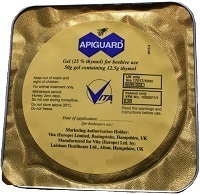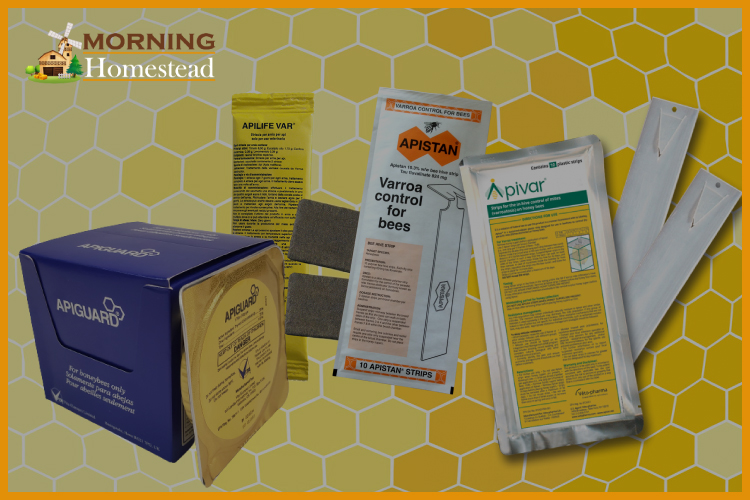Last Updated on June 14, 2023 by Georgie Smith
Where Does the Varroa Mite Come From?
The Varroa mite was discovered initially by Mr. A.C. Oudemans in late 1904. While checking his hives, he found a parasite on an Asian honey bee. During 1940, when the vast movement of transporting the western honey bee colonies in and out of Asia is how the Varroa mite found its home on honey bees.
The first mite then became popular with the honey bee with its early presence in Africa then later to Europe. Just as fast as one country was urgently looking for ways to kill the mite, another nation was taking heed of the trouble that their hives were in due to the quick spread of the Varroa mite.
In all accounts, the mites were discovered in the U.S. in 1987. As soon as the U.S. alerted countries around them, bordering Canada and Mexico urgently close their borders of receiving honey bees from the United States.
See Also:
The United States has provided a home for the mites for over twenty years now due to there being enormous beekeeping existence. By now, in 2019, the Varroa mite has made its way around the world with immense speed.

Around the World, the Varroa ravels
The Varroa Mite has made its way into the beekeeping world and is still a massive problem today. Beekeepers worldwide have to combat the Varroa mites because they are a significant setback to honey bees, their colony and their ability to produce untainted honey.
In the Bluegrass Region, the Varroa mite made its way through the Commonwealth in 1991, and today they occur throughout the states. Varroa mites feed and function externally as they attack both, the developing brood and the adult inside the colony.
They live off the colony by sucking the blood from both adults and drone brood. As this happens continuously, it shortens and weakens the life of the bee. (you can find more information at Best Beekeeping Books)
The affected brood often has deformities such as missing wings and legs. If the infestation goes untreated, the Varroa Mite will multiply and destroy the entire colony. If the hive is not examined, the beekeeper will merely credit the loss due to the hive being queenless or rough winter mortality.
The Varroa Mite develops on the bee brood. Each female mite enters the brood cell about a day before the forming so that it is trapped inside. Next, the immature mite emerges from the egg-laying and will develop on the matured bee larva.
By the time an adult bee emerges from the cell, some mites will be full adults, mated, and are ready to search for more larvae or bees to parasitize. By doing an inspection of the drone brood while in the capped cells, the keeper can usually determine if the hive is infested.
An infestation will be easy to determine due to the dark mites visible on the white pupae, the breaking of the comb, or when the pupae are pulled from the cells.
Mites expand by attaching themselves to the drones, and the worker bee continues infesting colony to colony. The mites can also spread due to the honey bees robbing smaller hives that are infected.
For precise detection, it is recommended to isolate the package bees, the swarm, and new colonies that were established from old colonies. This should be done before placing the bees and their hives in an apiary.
Symptoms of infestation
The signs of a Varroa Mite infestation can go without being noticed, even when it is too late. Although the parasite that feasts on the back of the honey bee is large enough that the naked eye can see, they are typically unnoticed.
During the summer season, most of the mites are nestled in the sealed brood – especially the drone brood which is the larvae that develop into males.
The enormously infested hives will typically appear healthy, even producing a lot of honey, yet they will dwindle and suddenly die in the winter or even the fall. That situation is often accelerated by the lack of nectar.
When is the Best Time to Treat Mites?
The earlier the detection there will be low levels of a mite infestation, the higher the chances are for successful management. However, well-developed infestations are easier to detect than low levels of the mites that have just begun.
When the bee population begins to decline, here is where the mite population continues to flourish. At this time more pregnant females roam the colony searching for the upcoming brood cells so they can lay their eggs.
If there is a decline of brood cells, the Varroa mite begins to double up and provide the one that is available. At the end of August, the hive is ready to expel the drones as they grow tired of them.
At this point, the queen bee is not laying many drones. Therefore the female mites choose the ones that survived; the worker brood. If the colony is untreated, it could have up to 6 mites for every 100 honeybees by the end of June.
Successful Treatments For the Varroa Mite:
Apivar:
This product carries the trade name for the treatment of Varroa Mites and is based on the chemical, Amitraz. Since 1969, the insecticide product considered a “hard” treatment with chemicals. The active ingredients are -[(methylamino) dimethylidyne] di-2,4-xylidine. The product’s active ingredient is Amitra.
Apivar cannot be utilized while the bees are making their honey and while supers are present. Also, the Apivar strip needs to be removed two weeks before the start of the honey flow to prevent contamination of the honey.
ApiLife Var:
The “soft” product is a treatment for the mites as well. This product is the name for the treatment of the Varroa mite. Its active ingredient is 74% thymol. Other components are camphor, menthol, and eucalyptol and are considered a “soft” chemical treatment. The product is a vapor/contact pesticide. Three successive applications are required when the bees are not actively making honey, and the supers are away from the hive.
Apiguard:
The product is the tradename for the treatment of the Varroa mite. Derived from the active ingredient, 25% thymol. It is available in a gel and considered a “soft” chemical treatment.
Apistan:
The active ingredient in Apistan is Fluvalinate. Apistan is a pyrethroid and is only one of three pesticides that are synthetics and formulated in a plastic strip. Apistan has been available for beekeepers since 1980 and worked incredibly well until illegal and repeated use of the unregistered versions used for Varroa mites caused resistance to fluvalinate. With very little exception, this product is no longer considered effective against the Varroa mites.
The Leading Products:
Mann Lake DC-799 Apivar (10 Pack)

Buy On Amazon
Apivar is used for Varroa mite treatment and is an Amitraz-based chemical that is proven to be safe and effective. Place the strips in the brood chamber one strip per 5 frames of bees to let the active ingredient release slowly over a six-week time span. At this time the bees come into contact with the strips then the active chemical kills up to 99% of the mites. There is no lasting residue left on the hives from the treatment.
Blythewood Bee Company Apiguard Pack For Varroa Mite Treatment

Buy On Amazon
This slow release is non-toxic, 50g pack helps combat Varroa Mites and Tracheal Mites. The active ingredient is 25 %Thymol which is derived from thyme which makes the product well-tolerated. There are 2-50 gm treatments to use per hive every 14 days. Apiguard is well tolerated by bees and leaves no harmful effect on the colony.
For the greatest results, treat when temperatures are between 60-105 degrees and not during spring flow.
How to Get Rid of Varroa Mites Naturally
Beekeepers that are serious about the health of their hives go all out for keeping their bees mite free. Even though there are other routes to take when you aim to kill Varroa Mites, the following methods beekeepers use to treat through natural processes.
- Mineral oil (food grade) in a propane fogger – This works because the mineral oil coats the mites and bees which will then cause the bees to groom one another causing the pesky insect to fall off.
- Powdered sugar –Powdered sugar works the same magic trick as Mineral oil. The perk of this method Is it is bound to taste better.
- The sacrificial drone brood – Beings the Varroa mite seems to have a preferred diet of the drone brood thanks to the extended incubation time. Removing and sacrificing the capped drone brood, this process would eliminate a lot of parasites.
The Varroa Mite continues to be the one that is the most destructive and deadliest parasite to affect bee colonies that are in existence. The parasite is no doubt dependent on the honey bee, and its presence due to having to have the bee complete its life cycle
One reason given in theory as to why the Varroa is so incredibly destructive is that they are somewhat new to Western honey bees. The majority of the parasites have other means of functional adaptions that prevent them from killing their host.
The Current Situation
Still today the Varroa mite is the most extensive problem for beekeepers around the globe. They are in every state in America, (except Hawaii). The mites have all but destroyed the wild bee existence that makes their homes in stumps, hollow trees, and numerous other cavities. And, unless hives are treated, the bee population will eventually weaken and die.
Wrapping This Up
It is no secret that wild, feral honey bee hives and colonies are rare to find. Although the countries are aware of the wide-spreading of the Varroa mite doing away with the natural lives of the vital honey bee, not much attention has gone to resolving the issue.
It is the world’s beekeepers that take every precaution of keeping the bees and their combs and honey as healthy and kite free as possible. Since its early detection in the late 1940s until today, the Varroa mite has become a global threat.
There have been new, natural measures to use to kill the mite before it is too late.
FAQs about Varroa Mites Treatment:
Q: Why Treat Against Varroa Mites?
A: If your colony goes untreated, the Varroa mites will weaken the bees, and you are basically condemning the bees to death.
Q. How can I prepare my bees for treatment?
A: It is vital that your bees remain well-fed. Monitor the infestation levels to keep the viruses under control. Colonies with high illness levels have a higher death toll.
Q: Can I see the mites?
A: Sometimes even when the mite is fully grown it can be hard for the human eye to see. But, many beekeepers have detected the mites just by observing their colonies.
How about you, are you a beekeeper? Maybe enthusiasts? Let us know your thought on the post, and if have some interesting feedback, we would love to hear from you. Please “like” our page and spread our story. Thank You for taking the time to read our post.


![The 6 Best Western Saddles For The Money: Guide & Review [2023] Best-Western-Saddles](https://morninghomestead.com/wp-content/uploads/2023/01/Best-Western-Saddles-150x150.jpg)


